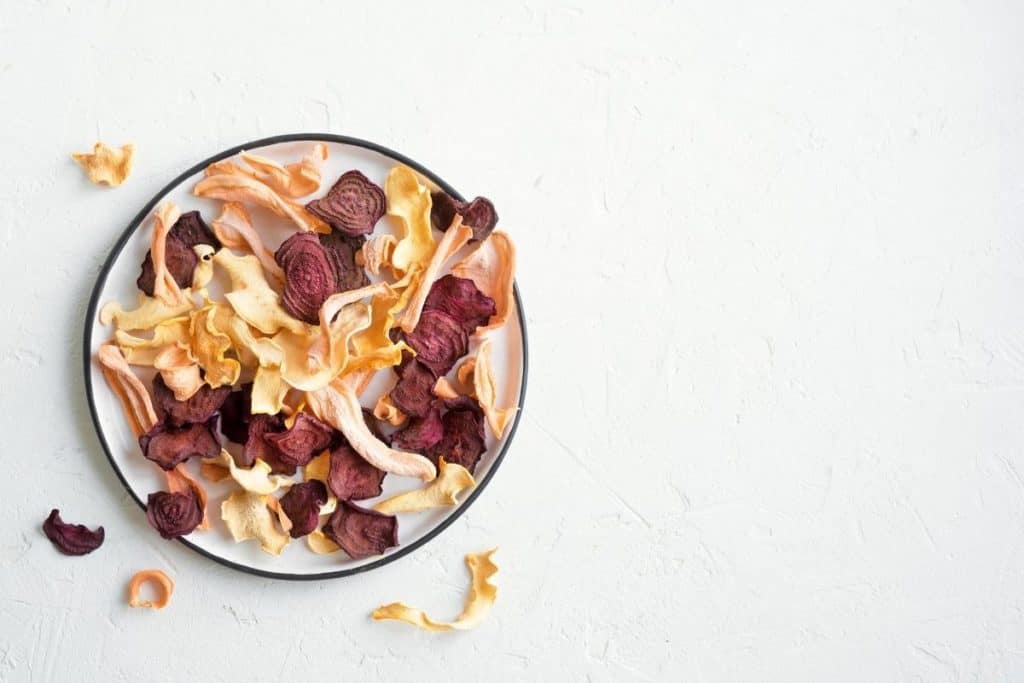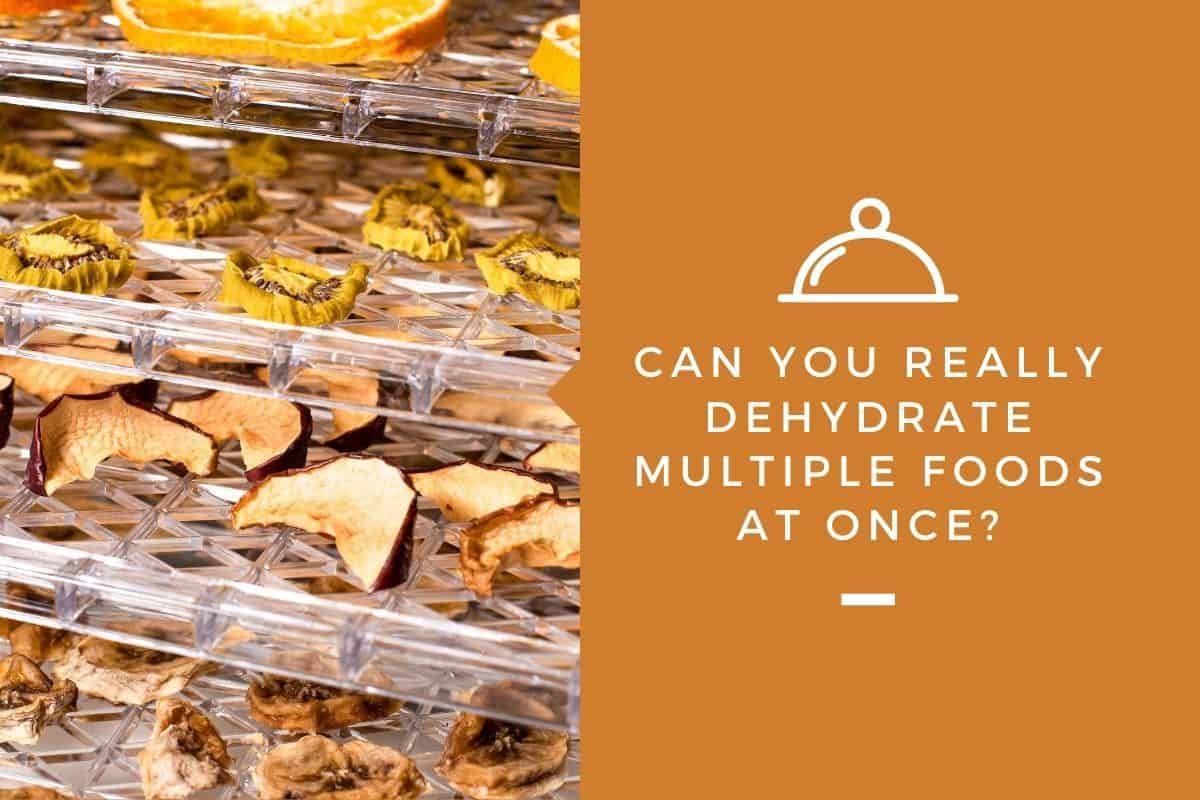Dehydrators can turn juicy fruits, beef, and vegetables into delicious dried-out snacks. Dehydrators dry out foods by heating air up to 130-160 degrees Fahrenheit then circulating it throughout the device for several hours, until the ingredients are completely dried out. Preparing, dehydrating, and storing a batch can take a long time, with the actual dehydration being the most time-consuming part of the procedure.
Because each and every batch requires a couple of hours, I can understand the appeal of dehydrating more than one food at a time, making the most of each session. Now, let’s find out what’s been said about it and how to do it.
Can you dehydrate multiple foods at once? Foods that are similar, such as different berries, can be dehydrated together. Other than that, you shouldn’t dehydrate different foods at the same time. Different foods may need to be dehydrated at different temperatures for different amounts of time. Mixing ingredients will also transfer taste and smell.
The idea of dehydrating is to pull water out of the foods and blow it away into the air until the ingredient has dried out completely. The air that is blown away (and circulates inside the dehydrator) will carry both scent and flavor. That’s why mixing foods from different categories isn’t recommended. Imagine dehydrating peaches and garlic at the same time.
The exception to this rule is when you’re dehydrating different ingredients but for the same recipe. If the ingredients are going to be mixed together later on, the transferred taste may not be as big of an issue as it would’ve been if you were to eat them separately.
Can You Dehydrate Multiple Fruits at Once?
Dehydrating fruit is very popular, there’s a wide variety of different fruits that taste great as dried-out snacks. Popular ones include bananas, apples, peaches, strawberries, cranberries, apricots, and much more. They can be used as toppings in salads or granola, or eaten as they are.
Fruits and berries are foods that actually mix well together. Neither fruits nor berries have much of a permeating odor, making it possible to dehydrate them together without impacting the taste or scent of either of the ingredients.
Most dehydrators come with more than one drying rack, when drying different fruits and berries, make sure to place the different fruits on different racks. Why?
Because your first fruit of choice may dry out quicker than your second fruit of choice. Having them on different racks makes it very easy to simply remove the rack when they seem to be dried-out. This is also done to prevent them from fusing together as juices are released and to keep taste-transfer to a minimum.
Not all foods contain the same amount of water and will, therefore, require more or less time in the dehydrator to completely dry out.
I suggest that you only mix fruits/berries that should be dehydrated at the same temperature when drying multiple foods at once. If the first recipe calls for 6 hours and the second one for 8 hours, simply remove the tray when 6 hours have passed. The same kind of adjustments can’t be made for temperature.
So, if you want to dehydrate multiple fruits at once, go ahead. As long as you don’t add beef jerky, garlic or fish – you should be fine.
Can You Dehydrate More Than One Herb at Once?
Yes, you can dry as many herbs as you need at the same time, as long as there’s enough tray space available. You don’t want them stacked on top of each other too much as it may shield parts of the herb from being dehydrated.
Compared to most foods, herbs dry very quickly in the dehydrator. I’ve fully dehydrated quite large batches of herbs in no more than 4 hours. It may sound like a lot but for anyone who has used a dehydrator, it’s not that much.
There’s very little taste and scent-transfer between herbs, which is why they’re perfect to dehydrate together. Once they’re finished dehydrating, they can be removed and stored immediately.
You should dehydrate them on the lowest possible setting, with each type of herb on its own tray so they don’t get mixed up when storing them later on.
Oh, I almost forgot. You don’t want to cut the leaves into very small pieces either. To avoid having a bunch of herbs flying around the dehydrator, I recommend leaving the leaves as they are and placing a fine screen over each tray, this will allow the leaves to breathe while they’re held down.
How Do I Dehydrate Multiple Foods Successfully?

To ensure that your success rate is increased to a minimum of 85-90%, I’ve compiled a couple of guidelines that I think you should go by when dehydrating multiple ingredients at the same time.
As you may know, there are two types of dehydrators, those with stackable trays and those designed to look like a small oven. Both types offer the possibility to use more than one drying rack at once. Actually, let me rephrase that; both types offer models capable of mounting more than one drying rack at once.
I’m using the Presto Dehydrator. It comes with 6 stackable trays but 6 additional ones can be mounted on it for a total of 12 trays, which I think is a bit too much but still a nice option to have. The 6 original trays are more than enough for me and my family. You can check it out on Amazon.
The first step to dehydrating multiple ingredients is making sure your dehydrator can hold more than one tray. Dehydrating different ingredients on one tray can be done but it’s not as convenient and to keep the foods from making contact, the batch may have to be restricted in size.
Now, with a dehydrator capable of holding more than one drying rack we can move on to the next step.
The second step is finding multiple foods that qualify to dehydrate at the same temperature. Dehydrating two things at once and adjusting the temperature for one of them is like sacrificing one food for the other. Find compatible foods. Temperature isn’t as easy to work with as cooking time.
The third step is to cut or slice the foods so that the pieces are even in size. I recommend using a mandolin for this step. To accompany the dehydrator, the mandolin is without a doubt the best accessory available on the market.
By making sure that your batch is even in size, you can make sure that every single piece will be dried-out at the same time. If you don’t own a mandolin, you may need to develop the ability to cut like a true chef.
The fourth step is placing the ingredients on the drying racks, one food per tray. Don’t create layers on the trays, give each piece space to breathe. When every piece is placed on the tray, place the tray in the dehydrator, and set the desired temperature.
Start the dehydrator and keep track of all the ingredients. Find out how long the different foods are supposed to dehydrate and remove them when they’re finished.
Store them separately in an air-tight jar in a cold, dark space. If they’re exposed to warmth or light, the herbs can deteriorate at a faster rate. You may want to crush the dried leaves to create a powder-like texture or keep them as they are to preserve flavor and aroma.
What Types of Food Should You Not Dehydrate at the Same Time?
You want to avoid mixing foods from different categories that smell and taste differently (e.g berries with beef). Dehydrating something spicy, such as chili, together with apples, may have an impact on the taste and smell of both foods. Try to dehydrate foods that are somewhat similar to each other to minimize the risk of ruining your batches.
Here’s a small list of things that are dehydrated on a regular basis and how compatible they are.
- Jerky: Should almost always be dehydrated alone. Jerky carries a distinct smell and tastes nothing like fruit. They’re even less compatible if there are spices involved.
- Fruits: Fruits can be dehydrated together with other fruits. Keep them on different trays. Fruits can also be dehydrated with berries.
- Mushrooms: I recommend dehydrating mushrooms separately too.
- Seafood: Definitely recommend dehydrating separately.
- Vegetables: Can be dehydrated with other vegetables as long as they’re on different trays or kept apart.
Conclusion
It seems like you can dehydrate different foods together but there are several guidelines that should be followed when doing so. However, if everything you’re dehydrating is going to end up in the same bowl and then eaten as a “mix” you may dehydrate the ingredients together. If the taste is transferred it won’t make a difference since the foods will be eaten all at once.
Good luck dehydrating! Thank you for reading!

